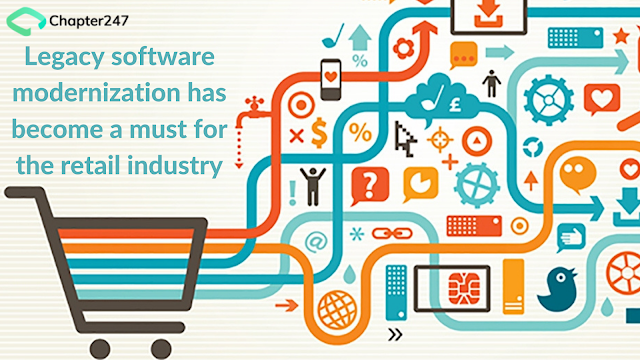Legacy software modernization has become a must for the retail industry
The need for Legacy software modernization
Business dynamics are changing every day making it difficult to get your software capabilities to keep up with the change. But it is often your software systems that can make or break your ability to adapt, grow, and most importantly remain competitive.
As customer behavior and enterprise norms have changed, business applications do not remain constant. Retailers now have to fulfill orders in a multichannel, multitouch E-commerce environment. All of these changes point out only in one direction which is legacy system modernization.
Gartner has predicted that every dollar invested in innovating in the year 2020 will require organizations to spend at least 3 times that to continuously modernize the legacy application portfolio. In order to ensure that the value you spend on legacy software modernization brings the maximum benefit, then you have to carefully consider which is the right approach for you. Let us see what these approaches are:
Complete transformation - If you are a retail organization that is looking at a complete transformation then the rebuild and replace model is best suited. The decision to choose this model comes with a thorough analysis of what has worked and what has not in the legacy system.
Gradual replacement - As the name implies, the goal is not to replace everything at once but gradually. The legacy system can be replaced component by component as the need arises. If your E-commerce site needs a facelift with new functionality for better user experience, then do so at the priority because that is what will drive your retail business. It should be prioritized based on what matters first to the customer.
Quick Fix - Quick fix also means that the retail organization has to make an assessment of the legacy system first, but the goal is to undertake patchwork with new code, processes, or applications. The biggest begins with an assessment of the biggest problems identified during the initial assessment and prioritized accordingly.
According to research, the modernized legacy software also successfully reduces the overall cost of business operations by more than 13%. Businesses with modern legacy systems could also enhance their annual revenue by at least 14% which is truly substantial.
Despite such encouraging penetrations, there are many retail organizations who are still stuck in the legacy systems. Over time, such systems throw errors, bugs, and critical issues in the way of successful organizations. In such times, when retail organizations are accelerating their pace to bring in technological transformations, the success of your retail business could take a back seat if you do not evolve.
Retail industry in dire need of legacy software modernization
Retail businesses are highly competitive because of the tremendous dynamicity of the industry. We are talking about not just the pandemic which is triggering change at a faster rate but also factors such as globalization, competition, and innovation. CBinsights has reported that 40 bankruptcies had been declared in retail from 2015 till March 2018. The biggest challenge by far has been the reducing traditional physical retail scenario because of the shift to digital commerce. During and after the pandemic fewer people will shop in traditional ways. Those retail businesses that do not understand the change will find it difficult to compete.
It is high time retailers modernize their software to optimize their operations and offer end-to-end customer experiences at faster speeds to increase customer retention.
Doesn’t matter if your software is old, it has to be integrated well without other tools and applications used to run your retail systems architecture. Let’s say for instance, you are planning to add live chat functionality, your systems should be able to integrate these new tools. If you are tied to the old legacy system, customers are sure to take the other route.
Legacy systems in the sector are not secure to use and considering it has vast customer data on the interface it becomes a problematic affair. In such cases, legacy systems lack updates, patches, and functionalities that adhere to newer software standards.
Older versions of the software trigger slower operational speed with time. It will then take loads of time to even perform the standard tasks. It is then the right time to contact a legacy software modernization company like ours to improve the process of software quality management and testing.
The older the application, the harder it becomes to support it more so when a non-dedicate third-party vendor is in the scene. The adversities increase in the retail organization when there is no one within the perimeters of the organization to solve it for you.
As said earlier, the retail industry is dynamic, where customer preferences keep changing, the software needs to change and meet modern demands. If the software is not scalable it will affect your brand image resulting in poor site traffic and revenues.
It is a myth that legacy software upgradation is expensive. In reality, the opposite is true because your obsolete application will take up more of your budget if you continue using it compared to legacy software modernization. The spending is mostly on the maintenance of legacy systems that may result in inefficiency, security gaps, and other risks.
Benefits of legacy software modernization to the retail sector
Innovation as a strategy - Meaning of innovation varies from person to person, but some things are stable like great leadership, risk-taking culture, a tech-driven workforce which always strides to map innovation to business value. Innovation also has to be meaningful and should be made if it solves any problems. Retailers who are progressive are already rethinking and rekindling their business systems and shifting their overall mindset by making the right moves.
More responsiveness
More and more burden is now being placed on digital systems to support critical customer needs. This puts excessive pressure on present digital systems and since you have not upgraded them, it puts undue pressure on them leading to poor customer response, longer customer buying cycles. But replacing this with modernized systems will make the processes more flexible. It will make your retail business more agile and the response system to customer queries only keeps getting better.
Enhanced security
One of the topmost reasons to consider modernizing legacy systems. Outdated systems make them highly vulnerable to malware attacks and data breaches. On top of that, if there is no support from the vendors then the matters become worse. You can’t seem to rely on systems that seemed secure 5 years ago. Modernization of legacy systems provides better security and protection to critical business operations like inventory management and customer support.
Better inventory
Consumers buy your products from channels that appeal to them the most. They can go to the store and buy the products which are mostly unlikely in the pandemic, or buy from online-pick-up-in-store, and mobile platforms. If your business is diversified enough to have your products being purchased and distributed through multiple channels, you’re already doing great. However, when these channels are managed in silos things can get complicated. If your online inventory stocks don’t communicate with your brick-and-mortar inventory stock, then fulfilling orders can get tricky.
Adding forecasting to strengthen business decisions
With software, upgradations come newer tools that lead to better forecasting with real-time information on stores, inventories, and a lot more. Insights can be derived from customer purchase behavior and product patterns can be used to determine the buying habits and current popularity of products.
The next step
Organizations should first focus on business capabilities, then their goals, and then the strokes of what modernization will do on both ends. If you are rebuilding only parts of the entire system, then layout a roadmap of how you plan to take apart the IT stack bit by bit. But whatever you decide, it will be best if you link up with a collaborative partner, a custom software development company that has already helped businesses to modernize their software.




Comments
Post a Comment